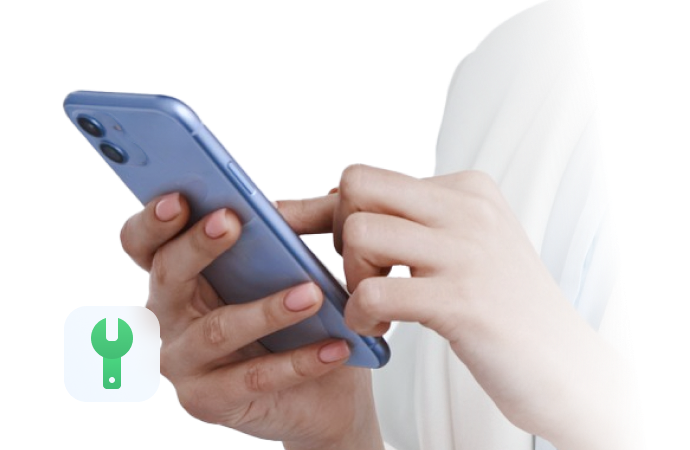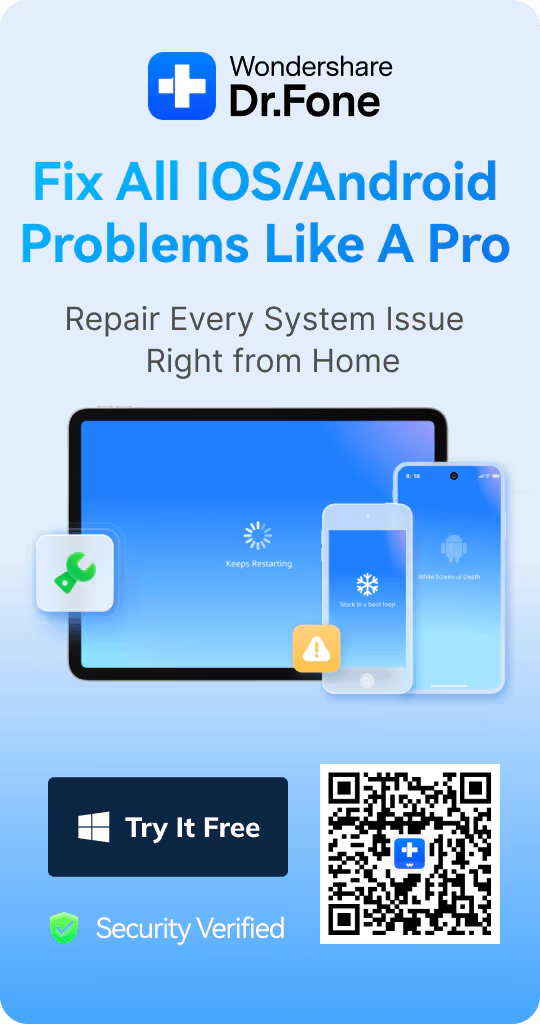
iPhone 16 Screen Not Responding to Touch: 7 Effective Solutions
Aug 20, 2025 • Filed to: Phone Repair Solutions • Proven solutions
Introduction
iPhone touch screen not working can disrupt your daily routine, preventing you from using applications, communicating, or unlocking your smartphone. This problem might occur abruptly, leaving people scurrying for rapid answers. In this article, we want to help you quickly address iPhone 16 screen responsiveness issues.
We'll cover seven practical remedies, including restarting your smartphone and complex system fixes with tools like Dr.Fone. These ways will allow you to restore control of your iPhone while avoiding pricey repairs. Continue reading to learn how to identify the underlying problem, make quick remedies, and avoid future screen troubles. By the end, you'll have all the tools to restore your iPhone 16 to perfect working condition.
Image Alt: iPhone Touch Screen Not Working
Part 1: Understanding the Issue: Why Isn't Your iPhone 16 Screen Responding?
An unresponsive screen is more than just a nuisance; it might indicate underlying problems with your iPhone 16. Before going into remedies, it's critical to identify the underlying source of the issue, which various circumstances might cause.
Common Causes for an iPhone Screen not Responding to Touch:
1. Software Glitches: Small software bugs are the most common cause of problems with how the screen responds. These may happen after an upgrade, a system crash, or app conflicts. Such faults might temporarily impair the touch sensitivity of your screen.
2. Hardware Issues: Physical damage, such as a broken screen or internal component failure, may cause touch problems. Dropping your phone or exposing it to dampness may damage its physical components, causing the screen to malfunction.
3. External Factors: Dirt, smudges, or an improperly placed screen protector might interfere with touch sensitivity. Extreme temperatures, whether hot or cold, might cause your screen to become momentarily unresponsive.
To diagnose the problem, start by:
· Check for Physical Damage: Examine your iPhone for noticeable fractures, dents, or water damage. Any indicators of damage may indicate that the issue is hardware-related.
· Restarting Your Device: A fast restart may cure any temporary software issues. Sometimes, a hard reboot may be required to resolve a frozen screen.
· Checking for Software Updates: Outdated software might cause touch sensitivity issues. Ensure your iPhone runs the most recent iOS version, as upgrades often address problems.
Part 2: Effective Solutions to Fix an Unresponsive iPhone 16 Screen
After identifying the reasons for your iPhone 16 screen, concentrate on effective treatments. From simple software errors to significant hardware issues, these seven solutions may restore iPhone functioning. Let's examine each solution.
1. Restart Your iPhone
A restart is one of the easiest and most efficient solutions to fixing iPhone screens that stopped responding. Restarting may fix minor software problems that impact touch. Memory overload, app conflict, or background activities stalling the machine may cause these issues.
How to force restart iPhone 16:
Step 1. Quickly press and release Volume Up.
Step 2. Rapidly press and release Volume Down.
Image Alt: Restart Your iPhone
Step 3. Hold the Side Button until the Apple logo shows, then release.
This restarts your iPhone and fixes any screen difficulties. Check for touch functionality after restarting your phone.
2. Check for Software Updates
If restarting your iPhone doesn’t work, check for outdated software. Apple constantly updates software to address issues, boost speed, and add capabilities. Older iOS versions may only work with some applications or hardware, causing difficulty with screen responsiveness.
Software upgrades often include essential solutions for known concerns. A recent update may have fixed a screen problem. Follow the steps below to check and install iPhone 16 Software Updates:
Step 1. Go to Settings. Tap General.
Step 2. Select Software Update.
Step 3. For updates to install, tap on Update Now.
Step 4. Complete the update by following on-screen directions.
Image Alt: Update Now
Turn ON your iPhone after installing the update to see whether screen responsiveness has improved. Updating your gadget regularly keeps it running smoothly.
3. Clean Your Screen
Smudges, filth, and dirt on your screen might affect touch sensitivity. Poorly applied or outdated screen protectors with bubbles or fractures may also hinder screen performance. Proper cleaning of the screen, particularly if the problem is minor, may restore touch responsiveness.
Capacitive touch screens employ finger electrical conductivity; dirt and smudges affect touch sensitivity. Dirt or an ill-fitted shield might impair conductivity, making the screen unresponsive. To properly clean the iPhone 16 Screen, perform the steps below:
Step 1. Power down your iPhone.
Step 2. Apply a delicate, lint-free cloth gently wet with water or screen-cleaning solution.
Image Alt: Clean iPhone Screen
Step 3. Smudges may be removed by gently wiping the screen in circles.
Note. Check screen protectors for bubbles, debris, and wear. If they're broken, consider getting a new one.
4. Check for Physical Damage
If screen cleaning fails, check for physical damage. Cracks, chips, or water may severely damage the Apple iPhone's touch capabilities. Physical harm may not be visible but may affect screen touch detection.
Why Physical Damage Is Important: If the screen is cracked, there may be places where touching it does not work. Water damage corrodes internal components, delaying the response. Learn how to Check Physical Damage:
1. Check the screen for chips and cracks.
2. Check your phone's edges for dents and bends.
3. Water damage may be detected by wetness beneath the screen or in the charging port.
Note. If physical damage is detected, contact an Apple Store or approved repair facility. Hardware damage typically requires expert Repair.
5. Disconnect wired accessories
Headphones and charging cords might affect iPhone touchscreen response. Poor cables or non-MFi-certified accessories might create electrical interference and touchscreen difficulties. Disconnecting a wired attachment may fix an unresponsive iPhone screen.
1. Unplug chargers and headphones.
2. Check for screen responsiveness improvements.
3. After disconnecting accessories, the screen may operate correctly. Replace the cable or use an officially approved product.
Image Alt: Disconnect Wired Accessories
6. Reset your iPhone
Restart your iPhone if none of the other options work. Resetting your smartphone to factory settings deletes all data, applications, and settings, eliminating software faults that cause touchscreen malfunctions before continuing to back up your data.
Resetting to factory settings erases everything on your iPhone and gives you a new start. This should only be used if previous fixes have failed, and software problems remain. To reset iPhone 16 to factory settings, follow the steps:
Step 1. Back up your iPhone to iCloud or your PC.
Step 2. Go to Settings.
Step 3. Tap on General > Transfer or Reset iPhone.
Step 4. Tap on Erase All Settings and Content.
Step 5. Confirm the reset using the on-screen prompts.
Image Alt: Erase this iPhone
7. Let it cool down
Extreme temperatures, mainly overheating, may hinder iPhone performance and screen response. After prolonged use or being left in a heated environment, your iPhone's touchscreen may cease operating until it cools. Let your smartphone cool to regain touch rapidly.
When your iPhone warms up, it immediately throttles performance to avoid harm to internal components. This may make the screen unresponsive or cease operating. Follow these tips to cool down your phone:
1. Turn off your iPhone and remove it from the heat.
2. Wait 10-15 minutes in a cool place (not the fridge or freezer).
3. After cooling, switch on your iPhone and test the screen.
Part 3: Going Beyond the Basics: Optimizing Your iPhone 16 with Dr.Fone
Basic troubleshooting may fix many iPhone 16 screen responsiveness issues, but sophisticated software issues require a more extensive solution. Here comes Dr.Fone—System Repair (iOS). A complete iPhone toolbox, Dr.Fone keeps your iPhone working smoothly. Its many functions analyze and solve common issues like unresponsive displays and enhance device performance.
Dr.Fone—System Repair is designed to fix sophisticated software bugs that cause system crashes and screen difficulties. Unlike simple solutions, it addresses internal iPhone bugs without damaging data. Dr.Fone can fix iPhone freezing, app crashes, and screen unresponsiveness.
How Dr.Fone Can Help with Screen Responsiveness Issues
1. System Repair for Touchscreen problems:
Diagnoses common software problems, including crashes, glitches, and unresponsive displays. It fixes screen touch difficulties, including iOS corruption, to make your iPhone 16 work properly.
2. Fixes iPhone Freezing or Lagging:
Dr.Fone's system repair utility helps fix unresponsiveness and sluggish performance on iPhone 16. Optimizing iOS stability prevents freezes and lags, improving reaction times.
3. Advanced System Optimization:
Dr.Fone enhances iPhone speed by removing unnecessary data and optimizing operations. This increases touch sensitivity and eliminates sluggishness or overloaded process-related touch difficulties.
4. No Data Loss Repairs:
Dr.Fone's system repair resolves iPhone software faults without destroying personal data. Dr.Fone protects your images, applications, and settings while repairing screen touch difficulties or system crashes.
How to repair screen responsiveness using Dr.Fone's System Repair:
Step 1. Download the toolkit from Dr.Fone.com. Install it on your PC.
Step 2. Launch Dr.Fone and attach your iPhone 16 via USB.
Image Alt: Open System Repair
Step 3. Select System Repair from the main menu. Menu > iOS Repair.
Image Alt: Select iOS Repair
Step 4. Choose between Standard and Advanced Mode. Standard Mode addresses most issues without data loss, so choose it first. If Standard Mode fails, try Advanced.
Image Alt: Choose Standard Repair Mode
Step 5. Find your iPhone model and download the right iOS firmware with Dr.Fone. Then, click Start to download.
Image Alt: Choose iOS Firmware
Step 6. After downloading the firmware, click Repair Now to fix the system. After fixing the issue, the utility will reboot your iPhone with a working screen.
Image Alt: Select Repair Now
Part 4: Additional Troubleshooting Tips
These troubleshooting tips may protect your device and avoid screen issues.
1. Protect Screen
A good screen protector protects your iPhone's screen from scratches and breaks and prevents dust, grime, and debris from affecting its touch sensitivity. Choose tempered glass screen covers for improved protection and touch response. Protectors also limit physical damage from drops, which might affect screen performance.
2. Check app compatibility
Some applications may need to be optimized for iPhone 16's iOS, causing screen latency or unresponsiveness. If an app freezes or becomes unresponsive, delete and reinstall it or check for updates. Check the App Store's compatibility to avoid installing applications with iPhone 16 difficulties.
3. Change Charging Cable
A bad or incorrect charging cable might affect your phone's touchscreen, especially during charging. See whether the problem occurs using an official or approved charging cord.
4. Check Moisture
Water might damage your iPhone's touchscreen. Even though the iPhone 16 is water-resistant, liquid may affect screen response. If your phone seems damp, dry it properly and prevent harsh temperatures that might cause condensation.
Conclusion
An unresponsive iPhone 16 screen may be annoying, but rebooting, cleaning, checking for physical damage, or upgrading the software will typically fix it. Consider environmental conditions like excessive temperatures or malfunctioning equipment to avoid more issues.
Dr.Fone - System Repair (iOS) fixes software bugs and optimizes performance for people with persistent screen troubles. Using Dr.Fone helps maintain your iPhone's health and avoid future difficulties. These procedures will keep your iPhone 16 working smoothly and reduce stress.
iPhone Issues
- iPhone Storage Full
- 1. Stuck on Apple Logo Storage Full
- 2. Erase Content Settings not Working
- 3. iPhone Lagging
- 4. iPhone Running Slow
- iPhone Update Problems
- 1. Stuck on Updating iCloud Settings
- 2. iPhone Frozen During iOS Update
- 3. iPhone Checking for Update Stuck
- 4. iPhone Cellular Update Failed
- 5. iPhone Software Update Failed
- 6. iPhone Stuck on Update Requested
- 7. iPhone Update Error 1110
- 8. iPhone Stuck On Verifying Update
- 9. iPhone Won't Update
- 10. Update Server Couldn't Be Contacted
- 8. iPhone & iPad Security Updates
- 9. Update iPhone with/without iTunes
- 10. Can't Download or Update Apps
- iPhone Media Problems
- 1. Apple Music Song Not Available
- 2. iPhone Not Ringing
- 3. iPhone Echo Problem
- 4. iPhone Ringer Problems
- 5. iPhone Plays Music by Itself
- 6. Ringer Volume Changes by Itself
- 7. Music Won't Play on iPhone
- 8. Blurry Photos & Videos on iPhone
- 9. iPhone Volume Problems
- iPhone Sound Problems
- 1. YouTube no Sound
- 2. iPhone Microphone Problem
- 3. Test iPhone Microphone
- 4. Headphones No Sound from iPhone
- 5. No Sound on iPhone Game
- 6. iPhone Sound Not Working
- 7. iPhone Screen Recording no Sound
- iPhone Calling Problems
- 1. iPhone No Sound on Calls
- 2. Screen Goes Black During Call
- 3. iPhone Recent Calls Not Showing
- 4. iPhone Dropping Calls Issue
- 5. iPhone Calling Problem
- iPhone Camera Problems
- 1. iPhone Camera Black
- 2. iPhone Camera Blurry
- 3. iPhone Camera Not Working
- 4. iPhone Front Camera Not Working
- 5. TrueDepth Camera Not Working
- 6.Out-of-Focus Photos on iPhone 15
- iPhone Network Problems
- 1. Airpods Won't Connect to iPhone
- 2. iPhone Disabled Connect to iTunes
- 3. iPhone Not Syncing Problems
- 4. iPhone Internet Not Working
- 5. iPhone Keep Disconnecting from Wifi
- 6. iPhone WIFI Not Working
- 7. PC Not Recognizing iPhone
- 8. iPhone Stuck on Connect to iTunes
- 9. iPhone Not Showing up in iTunes
- 10. iTunes Not Detecting Your iPhone
- 11. iPhone Bluetooth Disconnect
- 12.Apple CarPlay Keeps Disconnecting
- Other iPhone Problems

















Julia Becker
chief Editor
Generally rated4.5(105participated)